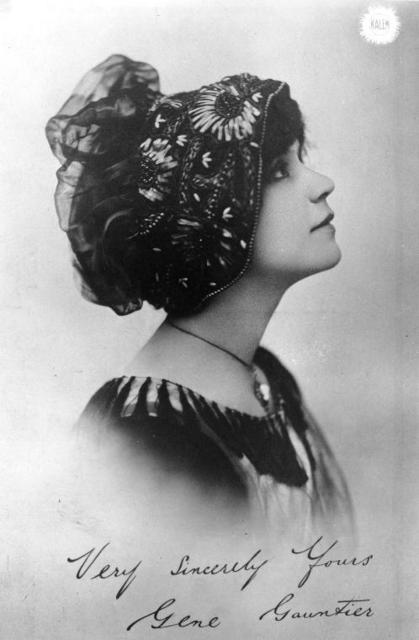by
Gretchen Bisplinghoff
During the years 1907-1912, Gene Gauntier, the first “Kalem Girl,” was the preeminent figure at the Kalem Film Manufacturing Company. She played key roles in the events that comprise established film history. She wrote the scenario for Ben Hur (1907), the work involved in the controversy that established the first copyright laws covering motion pictures, and wrote and acted in key films. In addition, she acted in the Nan, the Confederate Spy series: The Girl Spy (1909), The Girl Spy Before Vicksburg (1910), The Further Adventures of the Girl Spy (1910), cross-dressing forerunners of the serial action queens. She appeared in The Lad From Old Ireland (1910), the first film shot on location outside of the United States, and in From the Manger to the Cross (1912), the first feature-length treatment of the life of Christ. The Kalem Company was the first to make fiction motion pictures on location around the world, which has meant that 35mm film prints and other documents may have been deposited in archives outside the United States, the best example of which is the Irish Film Archives in Dublin, where one extant Gene Gauntier Feature Players title and five Kalem titles are archived (Condon 2008).
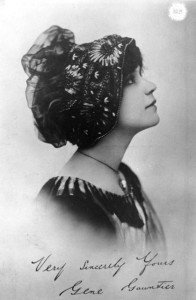
Gene Gauntier portrait. Private Collection.
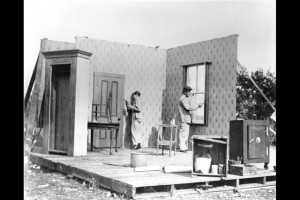
Gene Gauntier on location shooting. Courtesy of the Academy of Motion Picture Arts and Sciences, Margaret Herrick Library.
In December 1912 she left Kalem to form the Gene Gauntier Feature Players Company, a decision enthusiastically hailed by the Moving Picture World, which noted that she was popular “the world over” (1169). From Kalem, Gauntier brought with her longtime creative partner Sidney Olcott, to serve as director in her own production unit (Slide 1996, 117–118). However, their collaboration did not last long, and the cause of the disintegration of their working relationship remains unclear. In early 1914, the Moving Picture World reported that Sidney Olcott resigned as producer at the Gene Gauntier Feature Players Company to start his own Sid Olcott International Features. The article further states that Jack Clark—Gene Gauntier’s actor husband—would replace Olcott in this position, while Olcott would “retain his interest in the [Gauntier] company” (181). But by 1915, Gauntier and Jack Clark had joined the Universal Film Manufacturing Company, a move that would be short-lived. According to a letter from Gauntier dated June 28, 1915, addressed to “Colonel” William Selig, founder of the Selig Polyscope Company (written on Gene Gauntier Feature Film Company letterhead), they left Universal unhappily the same year they arrived, effectively the end of her motion picture career. Her last appearance was in The Witch’s Lure, alternatively titled The Witch’s Gold (1921).
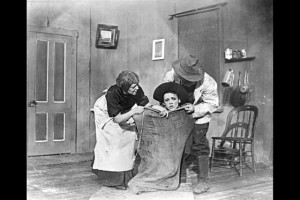
Gene Gauntier in Further Adventures of a Girl Spy (1910), Courtesy of the Academy of Motion Picture Arts and Sciences, Margaret Herrick Library.
Variations of the editor’s lament, “Why did she ever leave pictures!” haunt the retrospective consideration of early women film pioneers, but too often such lamentation focuses on individual success or failure rather than on systemic patterns within the industry. Within the Woman’s Home Companion introduction, Epes Winthrop Sargent, former reporter and managing editor of the Moving Picture World, suggests how quickly the trade press began to assess the events of a decade earlier, perhaps with nostalgia for a more innocent moment: “You who read the story Miss Gauntier has written will have a new conception of the motion picture industry in the making; of the brave souls who brought order out of chaos… The story presents an interesting contrast with the million-dollar methods of today, but it was Miss Gauntier and those with her who laid the foundations on which Hollywood was reared” (4). Two years before Terry Ramsaye’s A Million and One Nights, a history of cinema to 1925 commissioned by Photoplay, was published, Gauntier recalled these years in a 1924 Photoplay interview. This article’s title, “Unwept, Unhonored, and Unfilmed,” suggests an early awareness of the unfairness of changes that swept out the women who had made such significant contributions at the start (102). She makes one comment that suggests how she, at least, assessed these changes and understood how creative chaos in the early years favored women’s relatively full participation while a new order in the industry mandated against it (Staiger in Bordwell, Staiger, and Thompson 1985, 113–114). Summing up her own career trajectory in the Photoplay interview, she concludes that “After being master of all I surveyed, I could not work under the new conditions” (102).
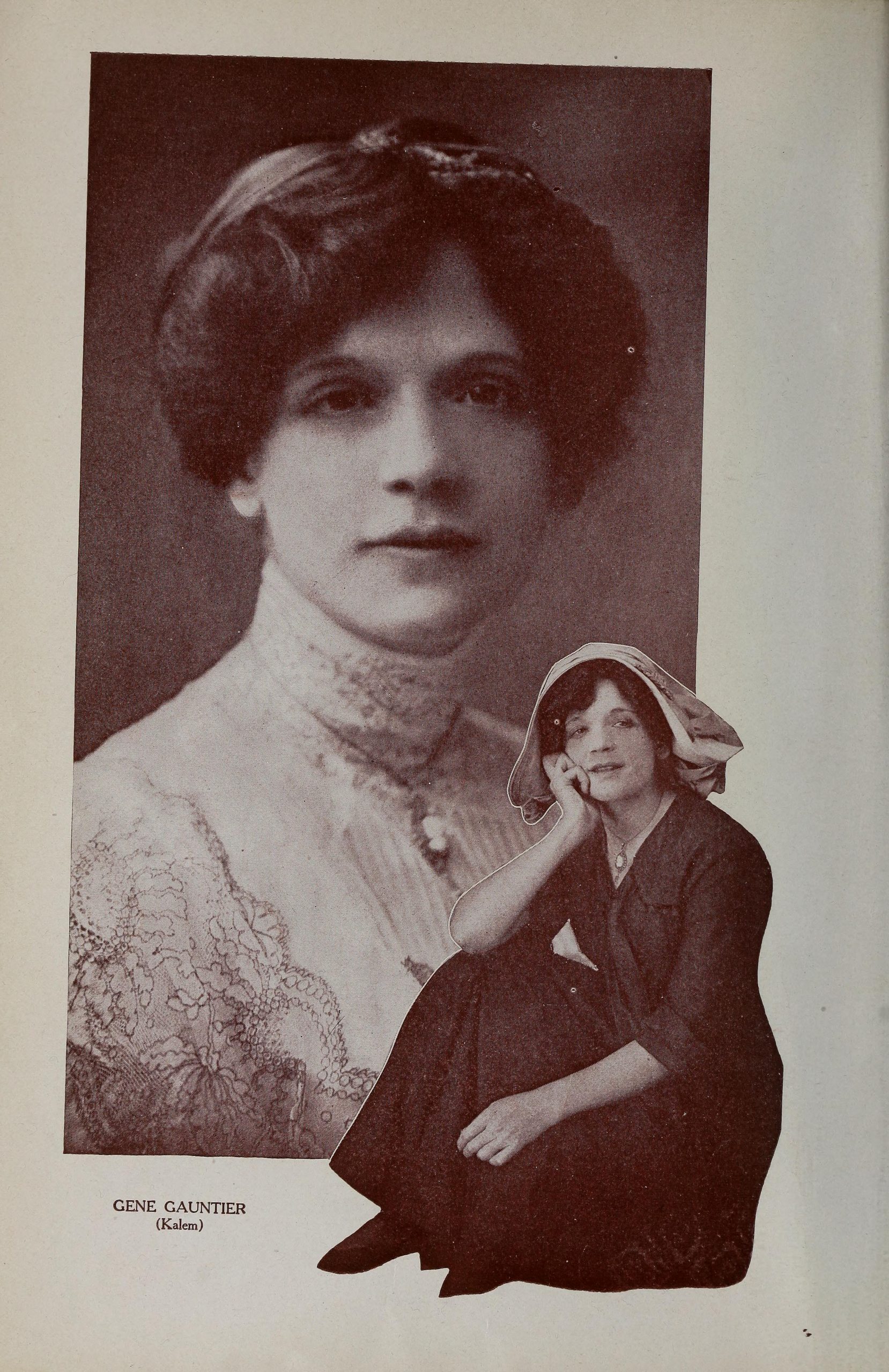
Gene Gauntier in Motion Picture Story Magazine (August 1912), p. 14.
Memoirs of silent film pioneers offer stories of lives and work told in first person voices, and the other women who wrote these memoirs, such as Alice Guy-Blaché, Frances Marion, Olga Petrova, Kathlyn Williams, need to be added to the standard sources of American film historical narratives written by, for instance, Samuel Goldwyn, Jesse L. Lasky, and Cecil B. DeMille. We now approach memoirs as a construction, or a blend of memory, fact, and fictionalization, and Gauntier is a colorful writer who begins, disarmingly, by claiming that she is not trying to “write a history,” but is only recalling those early days (1928, 7).
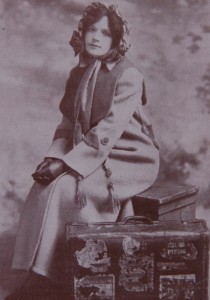
Gene Gauntier portrait. Private Collection.
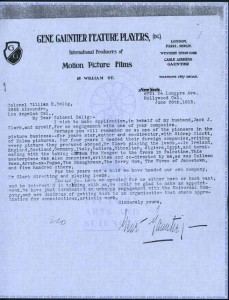
Scan, Gene Gauntier’s letter to William Selig. Courtesy of the Academy of Motion Picture Arts and Sciences, Margaret Herrick Library.
Gene Gauntier’s anecdotes in her memoirs complicate received historical narratives. One of the most interesting is her account of how, in 1907, working in the capacity of producer at the Biograph Company in the years when jobs were interchangeable, she gave his first directing assignment to an actor they then called “Larry” who would become legendary silent film producer-director D. W. Griffith (Stempel 18). But the memoir does not tell the full story of her collaboration with actor-director Sidney Olcott, nor does it mention her directing work other than to say that she disliked it. Olcott was the main credited director at Kalem and later at the Gene Gauntier Feature Players. He had arranged Gauntier’s first job in film at Biograph on Paymaster (1906), and both moved to Kalem, where they worked as the Olcott-Gauntier unit, leaving Kalem together to form her production company in 1912. One could say that their collaboration rendered much of her work invisible. Although “Blazing the Trail” does not stress the part she played in either codirecting or directing, she gives a different account of her work in private correspondence as well as to at least one fan magazine writer. In the 1915 letter to William Selig, when she is effectively looking for a job, she wrote about her work at Kalem: “For four years I headed their foreign companies, writing every picture they produced abroad, Mr. Clark playing the leads,—in Ireland, England, Scotland, Germany, Italy, Madiera [sic], Gibralter [sic], Algiers, Egypt, and terminating with the taking of From the Manger to the Cross in Palestine. This masterpiece was also conceived, written and codirected by me as was The Colleen Bawn, Arrah-na-Pogue, The Shaughraun, The Kerry Gow, The Wives of Jamestown, and five hundreds [sic] others.” Later in the 1924 Photoplay article, she also stressed her contributions, here, not to get a job, but to set the record straight: “In addition to playing the principal parts, I also wrote, with the exception of a bare half-dozen, every one of the five hundred or so pictures in which I appeared. I picked locations, supervised sets, passed on tests, co-directed with Sidney Olcott” (67; 101).
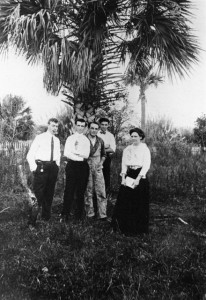
Gene Gauntier and Kalem stock company in Florida. Courtesy of the Academy of Motion Picture Arts and Sciences, Margaret Herrick Library.
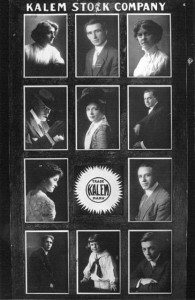
Kalem Stock Company 1910. Private Collection.
This evidence indicates how much more work still remains to be done to describe creative working relationships in the first decade that not only acknowledges individual contributions, but also redefines our understanding of roles in the early informal industry. This might acknowledge the crucial importance of the scenario writer who, in the prototypical case of the Kalem Company, was involved in so many aspects of creating a film. As for the prolific scenarist, Gene Gauntier—after her adventuresome motion picture career, she became a journalist, working as the film and drama critic for the Kansas City Post in 1919.
With additional research by Jane Gaines.
See also: Alice Guy-Blaché, Frances Marion, Olga Petrova, Kathlyn Williams, “Daughters of Mary and Gene: The Two Origins of the Serial Queen Action Heroine“
Bibliography
Bland, Robert Henderson. From Manger to Cross: The Story of the World-Famous Film Of the Life of Jesus. London: Hodder and Stoughton, 1922.
Condon, Denis. Early Irish Cinema 1895-1921. Dublin: Irish Academic Press, 2008.
The Daughter of the Confederacy. Rev. Motion Picture World. vol. 15, no. 4 (1 Mar 1913): 892, 1029
“Gauntier Feature Players.” Moving Picture World (12 December 1912): 1169.
Gauntier, Gene. “Blazing the Trail.” Woman’s Home Companion (Oct. 1928): 7-8, 181-84, 186; (Nov. 1928): 25-26, 166, 168-170; (Dec. 1928): 15-16, 132, 134; (Jan. 1929): 13-14, 94; (Feb. 1929): 20-21, 92, 94, 97-98; (March 1929): 18-19, 142, 146.
------. “Blazing the Trail.” Online access via The Silent Bookshelf: Blazing the Trail_1, Blazing the Trail_2, Blazing the Trail_3, Blazing the Trail_4, Blazing the Trail_5.
------. Letter to Colonel William Selig. June 28, 1915. Academy of Motion Picture Arts and Sciences, Margaret Herrick Library.
------. “Taking Pictures Under Difficulties. O’Kalems Brave Real Dangers and Endure Hardships in the Emerald Isle.” Moving Picture World (16 Sept. 1911): 784.
Harner, Gary. “The Kalem Company, Travel, and On-Location Shooting.” Film History 10 (1988): 118-207.
“New Picture Making Company.” Moving Picture World (10 Jan. 1914): 181.
“News of the Month.” Woman’s Home Companion (Oct. 1928): 4.
Smith, Frederick James. “Unwept, Unhonored, and Unfilmed.” Photoplay (July 1924): 64-67, 101-103.
Stempel, Tom. Framework: A History of Screenwriting in the American Film. New York: Continuum, 1991.
Archival Paper Collections:
Anthony Slide Collection. Academy of Motion Picture Arts and Sciences, Margaret Herrick Library.
“Blazing the Trail.” Typescript of the memoir. Museum of Modern Art, Film Study Center.
William Selig Papers. Academy of Motion Picture Arts and Sciences, Margaret Herrick Library.
Filmography
A. Archival Filmography: Extant Film Titles:
1. Gene Gauntier as Actress and Screenwriter or Possible Screenwriter
Ben Hur. Dir.: Sidney Olcott, Frank Oates Rose, sc.: Gene Gauntier (Kalem Company US 1907) cas.: H. Rottjer, Beal, Sheridan, Matler, si, b&w, 16mm & 35mm. Archive: Library of Congress, Fondazione Cineteca di Bologna, Cineteca del Friuli, Museum of Modern Art, UCLA Film & Television Archive, Academy Film Archive.
Hulda’s Lovers. Dir.: Wallace McCutcheon, sc.: Gene Gauntier (American Mutoscope & Biograph US 1908) cas.: Anthony O’Sullivan, Harry Solter, si, b&w, 16mm. Archive: Library of Congress.
The Girl Spy. An Incident of the Civil War. Dir.: Sidney Olcott, sc.: Gene Gauntier (Kalem Company US 1909) cas.: Gene Gauntier; si, b&w, 35mm. Archive: Library and Archives Canada.
The Further Adventures of the Girl Spy. Dir.: Sidney Olcott, sc.: Gene Gauntier (Kalem Company US 1910) cas.: Gene Gauntier, si, b&w, 35mm. Archive: BFI National Archive, Library of Congress.
The Girl Spy Before Vicksburg. Dir.: Sidney Olcott, sc.: Gene Gauntier (Kalem Company US 1910) cas.: Gene Gauntier, si, b&w. Archive: EYE Filmmuseum.
The Lad From Old Ireland. Dir.: Sidney Olcott, sc.: Gene Gauntier (Kalem Company US 1910) cas.: Gene Gauntier; si, b&w. Archive: IFI Irish Film Archive, BFI National Archive.
When Lovers Part. (Kalem Company US 1910) cas.: Gene Gauntier, si, b&w. Archive: EYE Filmmuseum.
The Colleen Bawn. Dir.: Sidney Olcott, sc.: Gene Gauntier (Kalem Company US 1911) cas.: Gene Gauntier, Jack Clark, si, b&w, 28mm. Archive: George Eastman Museum, IFI Irish Film Archive, Library and Archives Canada, BFI National Archive.
Her Chum’s Brother. Dir.: Sidney Olcott (Kalem Company US 1911) cas.: Gene Gauntier, Jack Clark, Alice Hollister, si, b&w, 35mm. Archive: Library of Congress.
The Fiddler’s Requiem. Dir.: Sidney Olcott, sc.: Gene Gauntier (Kalem Company US 1911) cas.: Gene Gauntier, Jack Clark, si, b&w. Archive: BFI National Archive.
The Little Soldier of ’64. Dir.: Sidney Olcott (Kalem Company US 1911) cas.: Gene Gauntier, Jack Clark, si, b&w. Archive: BFI National Archive.
Rory O’More. Dir.: Sidney Olcott, sc.: Gene Gauntier (Kalem Company US 1911) cas.: Gene Gauntier, Jack Clark, si, b&w. Archive: IFI Irish Film Archive, BFI National Archive, Academy Film Archive.
A Sawmill Hero. Dir.: Sidney Olcott (Kalem Company US 1911) cas.: Gene Gauntier, Jack Clark, si, b&w, 35mm. Archive: Library and Archives Canada.
Special Messenger. Dir.: Sidney Olcott (Kalem Company US 1911) cas.: Gene Gauntier, si, b&w. Archive: BFI National Archive, Library of Congress.
Tangled Lives. Dir.: Sidney Olcott (Kalem Company US 1911) cas.: Gene Gauntier, Jack Clark, si, b&w, 16mm & 35mm. Archive: Library of Congress, UCLA Film & Television Archive, Academy Film Archive.
A War Time Escape. Dir.: Sidney Olcott (Kalem Company US 1911) cas.: Gene Gauntier, Jack Clark, si, b&w. Archive: BFI National Archive, Archivo Nacional de la Imagen y de la Palabra - SODRE.
Ancient Temples of Egypt. Dir.: Sidney Olcott (Kalem Company US 1912) cas.: Gene Gauntier, Jack Clark, si, b&w, 16mm. Archive: George Eastman Museum.
Captured by Bedouins. Dir.: Sidney Olcott, sc.: Gene Gauntier (Kalem Company US 1912) cas.: Gene Gauntier, Jack Clark, si, b&w, 35mm. Archive: Library of Congress, BFI National Archive.
Down Through the Ages. Dir.: Sidney Olcott (Kalem Co. US 1912) si, b&w. Archive: BFI National Archive.
From the Manger to the Cross, or Jesus of Nazareth. Dir.: Sidney Olcott, sc.: Gene Gauntier (Kalem Company US 1912) cas.: Gene Gauntier, Robert Henderson-Bland, si, b&w, 35mm, 6 reels; 4, 780 ft. Archive: BFI National Archive, George Eastman Museum, Library of Congress, Wisconsin Center for Film and Theater Research, UCLA Film & Television Archive, Cinémathèque Royale de Belgique, Academy Film Archive.
His Mother. Dir.: Sidney Olcott (Kalem Company US 1912) cas.: Gene Gauntier, Jack Clark, si, b&w. Archive: EYE Filmmuseum (Dutch intertitles), IFI Irish Film Archive.
Winning A Widow. Dir.: Sidney Olcott, sc.: Gene Gauntier (Kalem Company US 1912) cas.: Gene Gauntier, Jack Clark, si, b&w, 16mm. Archive: UCLA Film & Television Archive, BFI National Archive.
You Remember Ellen. Dir.: Sidney Olcott, sc.: Gene Gauntier (Kalem Company US 1912) cas.: Gene Gauntier, Jack Clark, si, b&w, 35mm. Archive: George Eastman Museum, IFI Irish Film Archive.
2. Gene Gauntier as Actress, and/or Screenwriter, and/or Producer
Come Back to Erin. Prod.: Gene Gauntier, dir.: Sidney Olcott, sc.: Gene Gauntier (Gene Gauntier Feature Players US 1914) cas.: Gene Gauntier, Jack Clark, si, b&w. Archive: Museum of Modern Art.
For Ireland’s Sake. Dir.: Sidney Olcott (Gene Gauntier Feature Players US 1914) cas.: Gene Gauntier, Jack Clark, si, b&w, 16mm & 35mm. Archive: George Eastman Museum, BFI National Archive, IFI Irish Film Archive, Library of Congress, UC Berkeley Art Museum & Pacific Film Archive.
Through the Fires of Temptation. Dir.: Sidney Olcott (Gene Gauntier Feature Players US 1915) cas.: Gene Gauntier, Jack Clark, si, b&w, 35mm. Archive: Library of Congress [Note: only last reel survives.]
3. Gene Gauntier as Actress
The Paymaster. Dir.: Harrington (American Mutoscope & Biograph US 1906) cas.: Gene Gauntier, si, b&w, 16mm., 1 reel of 1, 274 feet. Archive: Library of Congress, UCLA Film & Television Archive, BFI National Archive.
The Skyscrapers/The Skyscrapers of New York. (American Mutoscope & Biograph US 1906) cas: Gene Gauntier, si, b&w, 16mm. & 35mm. Archive: Library of Congress, Academy Film Archive, UCLA Film & Television Archive, BFI National Archive.
Thaw-White Tragedy. (American Mutoscope & Biograph US 1906) cas: Gene Gauntier, si, b&w, 16mm. Archive: Library of Congress, UCLA Film & Television Archive, Academy Film Archive.
Betrayed by Handprints. Dir.: D. W. Griffith (American Mutoscope & Biograph US 1908) cas.: Gene Gauntier, Florence Lawrence, Mack Sennett; si, b&w, 16mm. Archive: Library of Congress.
The Girl and the Outlaw. Dir./sc: D. W. Griffith (American Mutoscope & Biograph US 1908) cas.: Gene Gauntier, Florence Lawrence, Mack Sennett; si, b&w, 16mm. Archive: Library of Congress.
Romance of an Egg. Dir.: Wallace McCutcheon (American Mutoscope & Biograph US 1908) cas.: Gene Gauntier, si, b&w, 16mm. Archive: Library of Congress, Academy Film Archive.
The Stage Rustler. Dir./sc.: D.W. Griffith (American Mutoscope & Biograph US 1908) cas.: D.W. Griffith, Eddie Dillion, Mack Sennett, Harry Solter, Linda Arvidson, Gene Gauntier, si, b&w. Archive: Library of Congress.
Thompson’s Night Out. Dir.: Wallace McCutcheon (American Mutoscope & Biograph US 1908) cas.: Gene Gauntier, Mack Sennett, si, b&w, 16mm. Archive: Library of Congress, Museum of Modern Art.
The Conspiracy of Pontiac; At Fort Detroit in 1763. Dir.: Sidney Olcott (Kalem Company US 1910) cas.: Gene Gauntier, Jack J. Clark, si, b&w, 35mm. Archive: EYE Filmmuseum.
The Navajo’s Bride. Dir.: Sidney Olcott [unconfirmed] (Kalem Company US 1910) cas.: Gene Gauntier [unconfirmed], Jane Wolfe, Frank Lanning, si, b&w, 35mm. Archive: EYE Filmmuseum.
For the Love of an Enemy. Dir.: Sidney Olcott [unconfirmed] (Kalem Company US 1911) cas.: Jack J. Clark, Gene Gauntier, si, b&w, 35mm. Archive: EYE Filmmuseum.
The Woman Hater’s Baby. (Powers Film Company US 1915) cas.: Gene Gauntier, Jack Clark, si, b&w, 35mm. Archive: Library of Congress.
The Witch’s Lure. Dir.: Nat G. Deverich (Capital Film Company US 1921) cas.: Gene Gauntier, si, b&w, 35mm. Archive: Library of Congress.
B. Filmography: Non-Extant Film Titles:
1. Gene Gauntier as Actress, Screenwriter or Possible Screenwriter, and Source Author
Tom Sawyer, 1907; As You Like It, 1908; Dolly, the Circus Queen, 1908; The Scarlet Letter, 1908; A Florida Feud, 1909; The Forager, 1909; The Man Who Lost, 1909; The Romance of a Trained Nurse, 1909; The Slave to Drink, 1909; The Castaways, 1910; An Irish Honeymoon, 1910; The Little Spreewald Madchen, 1910; The Stepmother, 1910; A Daughter of Dixie, 1910; Sailor Jack's Reformation, 1911; Arrah-na-Pogue, 1911; Far From Erin’s Isle, 1912; The Fishermaid of Ballydavid, 1911; Grandmother’s War Story, 1911; In Old Florida, 1911; The Lass Who Couldn’t Forget, 1911; Losing to Win, 1911; The Romance of a Dixie Belle, 1911; To The Aid of Stonewall Jackson, 1911; An Arabian Tragedy, 1912; Captain Rivera’s Reward, 1912; The Fighting Dervishes of the Desert, 1912; Far From Erin’s Isle, 1912; Ireland, the Oppressed, 1912; The Kerry Gow, 1912; The Mayor from Ireland, 1912; Missionaries in Darkest Africa, 1912; The O’Neill, 1912; A Prisoner of the Harem, 1912; The Shaughraun, 1912;Tragedy of the Desert, 1912; The Vagabonds, 1912; Lady Peggy’s Escape, 1913; The Little Rebel, 1913; When Men Hate, 1913; The Wives of Jamestown, 1913; Gene of the Northland, 1915.
2. Gene Gauntier as Actress, Screenwriter, and Producer (Gene Gauntier Picture Players)
A Daughter of the Confederacy, 1913.
3. Gene Gauntier as Actress and Producer (Gene Gauntier Picture Players)
The Mystery of Pine Creek Camp, 1913; Mystery of the Pine Tree Camp, 1913; In the Clutches of the Ku Klux Klan, 1914; Little Rebel, 1915.
4. Gene Gauntier as Actress
The Mad Maid of the Forest, 1915; The Smuggler’s Lass ,1915; The Ulster Lass, 1915.
5. Gene Gauntier as Director or Co-Director
The Grandmother, 1909.
C. DVD Sources:
Pioneers: First Women Filmmakers. DVD/Blu-ray. (Kino Lorber US 2018) - contains The Colleen Bawn (1911)
The Paymaster. DVD/VHS. Biograph Before Griffith vol. 2 (Facets Multimedia US 1990)
Spartacus. DVD (Grapevine Video US 2012)- contains Ben-Hur (1907) as an extra
The O'Kalem Collection. DVD (Irish Film Institute 2011) - contains Rory O'More (1911), The Colleen Bawn (1911), You Remember Ellen (1912), His Mother (1912), For Ireland's Sake (1914), Come Back to Erin (1914), His Mother (Dutch version), and documentary Blazing the Trail: The O'Kalems in Ireland (2011)
D. Streamed Media:
The Girl Spy Before Vicksburg (1910) via EYE Filmmuseum (Dutch intertitles)
When Lovers Part (1910) via EYE Filmmuseum (Dutch intertitles)
The Conspiracy of Pontiac (1910) via EYE Filmmuseum (Dutch intertitles)
The Lad from Old Ireland (1910) via Irish Film & TV Research Online
For the Love of an Enemy (1911) via EYE Filmmuseum (Dutch intertitles)
The Colleen Bawn (1911) via Irish Film & TV Research Online
Rory O'More (1911) via Irish Film & TV Research Online
His Mother (1912) via Irish Film & TV Research Online. Also available via EYE Filmmuseum (Dutch intertitles)
You Remember Ellen (1912) via Irish Film & TV Research Online.
Come Back to Erin (1914) via the Irish Film Institute.
For Ireland's Sake (1914) via Irish Film & TV Research Online.
Trailer for 2011 documentary Blazing the Trail: The O'Kalems in Ireland:
Credit Report
This filmography has been revised from references to her career made by Gene Gauntier in later correspondence. Anthony Slide (1996, 118), says that The Grandmother is the only title for which Gauntier “received published credit as director.” However, we found no source for this other than an advertisement in Moving Picture World. One needs also to consider both her comment in “Blazing the Trail” that she disliked directing and the letter to Capt. Selig that claims she was co-director on many films. It is assumed that Gauntier wrote most of the films made with Olcott, although this can’t always be confirmed through secondary references such as Paul Spehr, AFI, Richard Braff or the FIAF catalog. FIAF does not credit Gauntier for The Stage Rustler and Down through the Ages., but she is credited in Spher and Braff. FIAF does not credit her as the writer for these Kalem pictures: The Further Adventures of the Girl Spy, The Girl Spy, The Lad From Old Ireland, Her Chum’s Brother, The Fiddler’s Requiem, The Little Soldier of ’64, Rory O’More, A Sawmill Hero, Special Messenger, Tangled Lives, A War Time Escape, Ancient Temples of Egypt, His Mother, You Remember Ellen. However, she stated in her 1915 letter to Selig that she had written most of the Kalem pictures, so those films may have been written by her. FIAF Treasures does not credit her as the producer and/or writer of the Gene Gauntier Feature Players, Inc. pictures: Come Back to Erin and For Ireland’s Sake, but Spehr credits her as writer on Come Back to Erin. Treasures lists her as writer and cast on the Kalem titles The Lad From Old Ireland, The Coleen Bawn, and You Remember Ellen.
Citation
Bisplinghoff, Gretchen. "Gene Gauntier." In Jane Gaines, Radha Vatsal, and Monica Dall’Asta, eds. Women Film Pioneers Project. New York, NY: Columbia University Libraries, 2013. <https://doi.org/10.7916/d8-2bwk-7r27>





